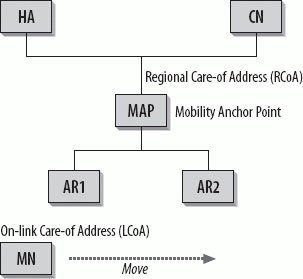Section 11.6. Extensions to Mobile IPv6
11.6. Extensions to Mobile IPv6A number of extensions have already been defined for Mobile IPv6 to make it more flexible and scalable. The following sections describe them. 11.6.1. NEMOAn extension to Mobile IPv6 called Network Mobility (NEMO) has been specified in RFC 3963. The NEMO Basic Support protocol enables Mobile Networks to attach to different points in the Internet. It allows session continuity for every node in the Mobile Network even as the Mobile Router changes its point of attachment to the Internet. It also allows every node in the Mobile Network to be reachable while moving around. The solution supports both mobile nodes and hosts that do not support mobility in the Mobile Network. The processes and messages are basically the same as in Mobile IPv6, except that in this case, the mobile node is a Mobile router. In the current NEMO specification, communication between nodes in the mobile network and correspondent nodes always goes through the home agent. Route Optimization has not been defined yet. Theoretically, nested mobility can be configured where a Mobile router allows another Mobile router to attach to its Mobile network. This opens ways for many scenarios with high mobility. The future will show how we use these technologies, and the developments in the past couple years show that sometimes unexpected applications spring up overnight and are used en masse. 11.6.2. Hierarchical Mobile IPv6With RFC 4140, "Hierarchical Mobile IPv6 Mobility Management," the scalability of Mobile IPv6 is further extended. It is designed to significantly enhance performance of Mobile IPv6 and to reduce the number of messages a mobile node sends over a link in order to update its bindings with the home agent and the correspondent node. It also allows mobile nodes to hide their location from correspondent nodes and home agents when using route optimization. Hierarchical Mobile IPv6 introduces a new node type, the Mobility Anchor Point (MAP). The MAP can be located anywhere in the hierarchical network of routers. It is essentially a local home agent in the geographical region of the mobile node. The mobile node now sends binding updates to the local MAP rather than to the home agent and correspondent nodes. By sending one binding update message to the MAP, all further traffic from the home agent and the correspondent nodes is rerouted to the new location of the mobile node. The correspondent node and home agent operation are not affected by this and therefore need no changes. Figure 11-7 illustrates the concept. Figure 11-7. Hierarchical Mobile IPv6 When the mobile node enters a MAP domain, it receives Router Advertisements containing information on one or more local MAPs (MAP option). The Regional Care-of Address (RCoA) of the MAP corresponds to the care-of address in the base MIPv6 specification. After registering with a MAP, the mobile node registers its RCoA with its home agent and eventually with its current correspondent nodes. The RCoA is now used as the mobile node's care-of address. It is the address used by the home agent and correspondent nodes to communicate with the mobile node away from home. When the mobile node moves from one network to another within a MAP domain, it registers its new On-link Care-of Address (LCoA) with the MAP. The MAP, acting like a local home agent, receives all packets on behalf of the mobile node and will encapsulate and forward them to the mobile node's current address. The boundaries of a MAP domain are defined by the Access Routers (AR1 and AR2 in Figure 11-7). This obviously greatly enhances performance of Mobile IPv6, because binding updates do not have to be sent to the home agent and the correspondent nodes every time the mobile node moves to another network within the MAP domain. As mentioned in the section on the Binding Update message, a new bit has been added to the Binding Update message, the M-bit, which indicates that this is a MAP registration and not a Binding Update with a home agent. There is also an extension to Neighbor Discovery specified to include the MAP's global IPv6 address. A MAP can exist anywhere in the hierarchical network. Several MAPs can be located within the same domain independently. In addition, overlapping MAP domains are allowed and recommended. Both static and dynamic hierarchies are supported. 11.6.3. Fast HandoverIn RFC 4068, a protocol is specified to reduce the mobile node's handover latency when moving from one network to another. It is called "Fast Handover for Mobile IPv6." The handover operationally consists of movement detection, address configuration, and address update. The combined handover latency is often sufficient to affect real-time applications (e.g., VoIP). This specification describes a set of protocols and procedures to significantly reduce the handover latency. All throughput-sensitive applications can benefit from the Fast Handover. RFC 4260, "Mobile IPv6 Fast Handovers for 802.11 Networks," discusses and gives some deployment examples for Mobile IPv6 Fast Handovers on 802.11 networks. Now that you have worked through all aspects of IPv6, the next chapter invites you to get your hands dirty. Experience comes from using technology. Enjoy IPv6! |